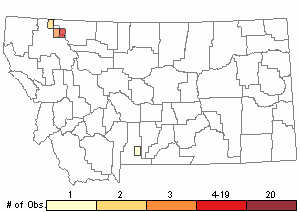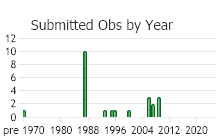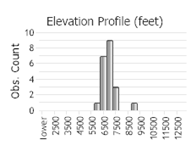View in other NatureServe Network Field Guides
NatureServe
Montana
Utah
Wyoming
Idaho
Wisconsin
British Columbia
South Carolina
Yukon
California
New York
Goose-grass Sedge - Carex plectocarpa
Other Names:
Carex lenticularis var. dolia
State Rank Reason (see State Rank above)
Known in Montana primarily from Glacier National Park and from one population in the Absarokas. Some plants in the Logan Pass area are subject to trampling by hikers. Otherwise, the potential for negative impacts to the species appears to be low.
- Details on Status Ranking and Review
Population Size
Score1-2 - Small to Moderate. Population size is imprecisely known but is believed to be >2,000 individuals and <100,000 individuals.
CommentLikely over 10,000 plants but available data are imprecise.
Range Extent
Score3 - Local Endemic or Very Small Montana Range: Generally restricted to an area <10,000 sq. miles (equivalent to the combined area of Phillips and Valley Counties) or <6 Sub-basins (4th code watersheds) Range-wide OR limited to one Sub-basin in Montana
CommentGlobal range includes Glacier National Park and the Beartooth Plateau.
Area of Occupancy
Score2 - Low: Generally occurring in 4-10 Subwatersheds (6th Code HUC’s).
CommentKnown from 5 subwatersheds.
Environmental Specificity
Score1 - Moderate: Species is restricted to a specific habitat that is more widely distributed or to several restricted habitats and is typically dependent upon relatively unaltered, good-quality habitat (C Values of 5-7).
Trends
Score0-1 - Stable to Minor Declines:
Threats
Score1 - Medium: 11-30% of the populations are being negatively impacted or are likely to be impacted by one or more activities or agents, which are expected to result in decreased populations and/or habitat quality and/or quantity.
CommentTrampling at the Logan Pass area population has been identified as a potential impact.
Intrinsic Vulnerability
Score0-1 - Low to Moderate Vulnerability.
Raw Conservation Status Score
Score
8 to 11 total points scored out of a possible 19.
General Description
Caespitose. Stems ascending to prostrate, 5–30 cm. Leaves basal and cauline; blades 1–3 mm wide. Inflorescence of 3 or 4 short-pedunculate, overlapping spikes; lowest bract shorter or longer than the inflorescence. Spikes 8–20 mm long; uppermost bisexual with male flowers below; lower spikes female. Perigynia ovate, ascending, green and purple-blotched, 2–3 mm long with a beak, ca. 0.2 mm long; stigmas 2. Female scales narrowly ovate, blackish with a pale midvein, shorter than the perigynia. Achene 2-sided, smaller than the perigynium (
Lesica et al. 2012. Manual of Montana Vascular Plants. BRIT Press. Fort Worth, TX).
Phenology
Fruit mature in late July-August.
Diagnostic Characteristics
Carex is a very large genus, making identification of individual species sometimes difficult. Specimens with mature fruit are necessary for positive identification. Perhaps the best field characters are the loose tussocks with the leaves and stems generally growing at a near-horizontal angle to the ground.
Species Range
Montana Range
Range Descriptions

 Native
Native
Range Comments
Endemic to Glacier National Park, Park County, MT and adjacent WY (Lesica et al. 2012. Manual of Montana Vascular Plants. BRIT Press. Fort Worth, TX).
Observations in Montana Natural Heritage Program Database
Number of Observations: 25
(Click on the following maps and charts to see full sized version)
Map Help and Descriptions
Relative Density

Recency



 (Observations spanning multiple months or years are excluded from time charts)
(Observations spanning multiple months or years are excluded from time charts)
Habitat
Shallow, wet, stony soil around streams in the alpine zone.
National Vegetation Classification System Groups Associated with this Species
Wetland and Riparian
Alpine Riparian and Wetland
Stewardship Responsibility
Threats or Limiting Factors
STATE THREAT SCORE REASON
Validated observations of Goose-grass Sedge occur in Glacier National Park (GNP) and Park County, Montana and adjacent Wyoming (Lesica et. al. 2012). Reported threats to populations in GNP are associated with recreational use where Goose-grass Sedge occurs (MTNHP Threat Assessment 2021). A major population is at Logan Pass where concentrated recreation occurs and the potential for National Park Service facility development has been reported as a concern. Other populations occur along climbing routes and hiking trails which may be exposed to trampling. Information on the scope, severity, and/or timing of these threats is needed.
References
- Literature Cited AboveLegend:
 View Online Publication
View Online Publication Dragon J.A. and D.S. Barrington. 2009. Systematics of the Carex aquatilis and C. lenticularis Lineages: Geographically and Ecologically Divergent Sister Clades of Carex Section Phacocystis (Cyperaceae). American Journal of Botany 96(10): 1896-1906.
Dragon J.A. and D.S. Barrington. 2009. Systematics of the Carex aquatilis and C. lenticularis Lineages: Geographically and Ecologically Divergent Sister Clades of Carex Section Phacocystis (Cyperaceae). American Journal of Botany 96(10): 1896-1906. Lesica, P., M.T. Lavin, and P.F. Stickney. 2012. Manual of Montana Vascular Plants. Fort Worth, TX: BRIT Press. viii + 771 p.
Lesica, P., M.T. Lavin, and P.F. Stickney. 2012. Manual of Montana Vascular Plants. Fort Worth, TX: BRIT Press. viii + 771 p. MTNHP Threat Assessment. 2021. State Threat Score Assignment and Assessment of Reported Threats from 2006 to 2021 for State-listed Vascular Plants. Botany Program, Montana Natural Heritage Program, Helena, Montana.
MTNHP Threat Assessment. 2021. State Threat Score Assignment and Assessment of Reported Threats from 2006 to 2021 for State-listed Vascular Plants. Botany Program, Montana Natural Heritage Program, Helena, Montana.
- Additional ReferencesLegend:
 View Online Publication
View Online Publication
Do you know of a citation we're missing? Hermann, F.J. 1964. A new Carex from Glacier National Park, Montana. Leaflets Western Botany 10:65-68.
Hermann, F.J. 1964. A new Carex from Glacier National Park, Montana. Leaflets Western Botany 10:65-68. Lesica, P. 1988. Report on the conservation status of Carex lenticularis var. Dolia, a candidate threatened species. Unpublished report, Glacier National Park, Montana 50 pp.
Lesica, P. 1988. Report on the conservation status of Carex lenticularis var. Dolia, a candidate threatened species. Unpublished report, Glacier National Park, Montana 50 pp. Lesica, P., M.T. Lavin, and P.F. Stickney. 2022. Manual of Montana Vascular Plants, Second Edition. Fort Worth, TX: BRIT Press. viii + 779 p.
Lesica, P., M.T. Lavin, and P.F. Stickney. 2022. Manual of Montana Vascular Plants, Second Edition. Fort Worth, TX: BRIT Press. viii + 779 p. Standley, Lisa A. 1985. "Systematics of the Acutae Group of Carex (Cyperaceae) in the Pacific Northwest". Systematic Botany Monographs. 7: 1-106.
Standley, Lisa A. 1985. "Systematics of the Acutae Group of Carex (Cyperaceae) in the Pacific Northwest". Systematic Botany Monographs. 7: 1-106.
- Web Search Engines for Articles on "Goose-grass Sedge"





